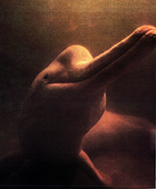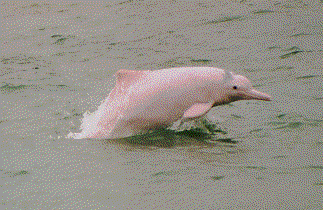
The River Dolphin of Amazon River: The Bouto

A lot of "legends" had been told about our unquiet cetacean playful and inoffensive. Some give him property of mystery, he can mutate himself in a good looking boy to seduce girls and then shoot a spell on them so they got pregnant. In a part of Amazonas people were sure that when the girls appeared pregnant, the bouto had seduced them. And with this affirmative they fathered the childrem to the bouto.
Classification
Common Name:
Bouto
Scientific
Name: Inia geoffrensis
Phylum:
Chordata
Class:
Mammalia
Order:
Cetacea
Family:
Platanistidae
Geni:
Iniidae
Habitat - Geographic Range
Freshwater
River systems, not near waterfalls or estuaries.
Neotropical.
Found in the Amazon, Negro, Mamore,and Orinoco River systems of Peru, Ecuador,
Brazil, Bolivia, Venezuela, and Columbia.

Physical Characteristics
Mass: 95 to 160 kg
South American river dolphins are the largest of the river dolphins, with males averaging 2,550mm and females 2,010mm in length. Despite the weight of their body they are very flexible. The young are born slate grey and turn a blotchy pink as they mature. Bristle hairs on their snouts provide sensory information. They have small eyes, but in clear water their vision is reportedly very good. Its snouts are long and pointed with many small teeth. The pectoral fins are large and broad, and they are lacking distal and dorsal fins, they rarely jump out of the water like ocean dolphins.

Inia geoffrensis's
skull
Food Habits
Then boutos zigzag between trees of the inundated forest in search of fish, river turtles, and crabs.
Reproduction
There is a
breeding season in late October to early November, with births occurring
8.5 months later in May to July at the time of peak water levels.
Young are
800mm at birth and in captivity grow 200mm a year. Length of nursing is
unclear, but an indiviual was found with a nursing calf a year after its
birth.


Behavior
These animals are usually solitary or found in mother-offspring pairs. Loose aggregations form for feeding and mating. They are usually slow swimmers, but capable of short bursts of speeds up to 23 km/hr. These river dolphins are reported to be curious and playful, and even in the wild they may be tame with humans.
When the river systems flood, the dolphins go out over the land and manage to navigate their through trees to find theirway back to the rivers.
Conservation/Biodiversity
Human pressures
are causing population concerns. Seine and gill nets pose a real threat
to dolphins that get caught in them. Also, hydroelectric power stations
are causing changes in fish concentrations and the isolation of dolphin
populations within river systems. Another problem is that mercury, which
is used in refining
fluvial gold, is
found in high concentrations in the fish the dolphins consume.
There is little direct hunting of these river dolphins, but if one is found dead its fat is used for lamp oil, and its eyes and genetalia as love charms. The meat is not used. Fisherman use them to locate school of fish.
![]()

![]()